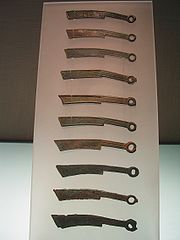
Knife money
Encyclopedia

Casting
In metalworking, casting involves pouring liquid metal into a mold, which contains a hollow cavity of the desired shape, and then allowing it to cool and solidify. The solidified part is also known as a casting, which is ejected or broken out of the mold to complete the process...
, bronze
Bronze
Bronze is a metal alloy consisting primarily of copper, usually with tin as the main additive. It is hard and brittle, and it was particularly significant in antiquity, so much so that the Bronze Age was named after the metal...
, knife
Knife
A knife is a cutting tool with an exposed cutting edge or blade, hand-held or otherwise, with or without a handle. Knives were used at least two-and-a-half million years ago, as evidenced by the Oldowan tools...
-shaped coin
Coin
A coin is a piece of hard material that is standardized in weight, is produced in large quantities in order to facilitate trade, and primarily can be used as a legal tender token for commerce in the designated country, region, or territory....
s produced by various governments and kingdoms in what is now known as China
China
Chinese civilization may refer to:* China for more general discussion of the country.* Chinese culture* Greater China, the transnational community of ethnic Chinese.* History of China* Sinosphere, the area historically affected by Chinese culture...
, approximately 2500 years ago. They had holes on the end to be easily strapped onto belts or rings. Known as jin cuo dao (金错刀) in Chinese, knife money circulated in China between 600 to 200 B.C. during the Zhou dynasty
Zhou Dynasty
The Zhou Dynasty was a Chinese dynasty that followed the Shang Dynasty and preceded the Qin Dynasty. Although the Zhou Dynasty lasted longer than any other dynasty in Chinese history, the actual political and military control of China by the Ji family lasted only until 771 BC, a period known as...
.
History
There are several stories that attempt to explain how knife money was introduced but it is not certain if any or all are true. In one story a prince who was running low on money to pay his troops allowed them to use their knives as a form of currency to barter with villagers and the medium became so popular that it became generally accepted. In another story, the same prince began accepting knives as payment for small fines in the place of the current legal ring currencyChinese currency
The Renminbi is the official currency of the People's Republic of China . It is the legal tender in mainland China, but not in Hong Kong and Macau. It is abbreviated as RMB, and the units for the Renminbi are the Yuan , Jiao , and Fen : 1 Yuan = 10 Jiao = 100 Fen. Fen have almost disappeared, so...
. Knife money may also have been brought in by sea traders from the Indian Ocean
Indian Ocean
The Indian Ocean is the third largest of the world's oceanic divisions, covering approximately 20% of the water on the Earth's surface. It is bounded on the north by the Indian Subcontinent and Arabian Peninsula ; on the west by eastern Africa; on the east by Indochina, the Sunda Islands, and...
. Throughout time the knife currency slowly shrank until only the ring of the handle was produced as a symbol of the knife that it represented.
See also
- Economy of the People's Republic of ChinaEconomy of the People's Republic of ChinaThe People's Republic of China ranks since 2010 as the world's second largest economy after the United States. It has been the world's fastest-growing major economy, with consistent growth rates of around 10% over the past 30 years. China is also the largest exporter and second largest importer of...
- Economic history of China (Pre-1911)
- Economic history of ChinaEconomic history of ChinaChina's economic system before the late-1990s, with state ownership of certain industries and central control over planning and the financial system, has enabled the government to mobilize whatever surplus was available and greatly increase the proportion of the national economic output devoted to...
External links
- "Fragments of a stone mould and bronze knife money" (description and picture from the British MuseumBritish MuseumThe British Museum is a museum of human history and culture in London. Its collections, which number more than seven million objects, are amongst the largest and most comprehensive in the world and originate from all continents, illustrating and documenting the story of human culture from its...
) - "Chinese Knife Money of the State of Ming" (description and pictures from Birmingham Museums & Art Gallery)
- Different types of knife money with brief explanations

